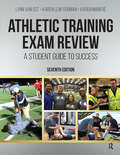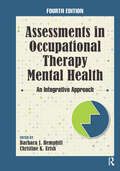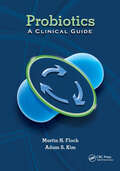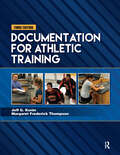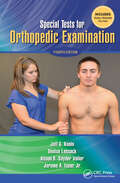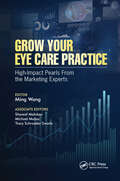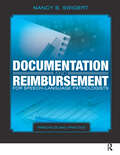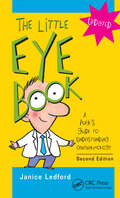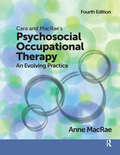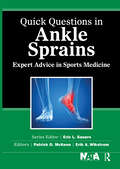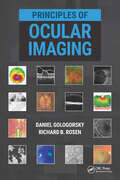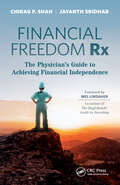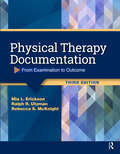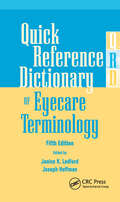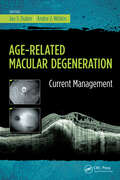- Table View
- List View
Athletic Training Exam Review: A Student Guide to Success
by Lynn Van Ost Karen Lew Feirman Karen ManfriFor more than 20 years, Athletic Training Exam Review has empowered and enabled students to assess and evaluate their athletic training knowledge, skills, and decision-making abilities. Now, newly updated for its platinum anniversary, the Seventh Edition continues a tradition of excellence while serving as a premier guide to successfully achieving certification as an athletic trainer.The Seventh Edition serves as a comprehensive self-evaluation tool, elevating readers’ level of preparation for the BOC exam. This market-leading guide has made a positive impact on the athletic training profession by highlighting and improving students’ strengths and weaknesses.What’s inside: Updated study techniques and test-taking strategies An expanded overview of the exam format to assist in organization and planning More than 1,300 multiple-choice questions and nearly 100 true/false questions, updated and organized according to the BOC’s Practice Analysis, Seventh Edition Educational Domains Clinical decision-making questions testing the ability to make appropriate judgment calls using problem solving A skills assessment composed of 26 problems designed to test manual athletic training skills Scenario-based problems to strengthen critical-thinking abilities In addition to the updated content, the Seventh Edition also features a fully redesigned and expanded online test-taking experience, including: New user-friendly, mobile format 8 knowledge assessment tests—3 more than the previous edition! 5 unique true/false exams 20 total drag and drop identification photographs—8 more than the previous edition! 43 critical-thinking scenarios 3 clinical decision-making exams containing scenario-based exam questions 13 video segments with related questions for practicing evaluation and assessment Athletic Training Exam Review has assisted thousands of students and has become a hallmark text around the globe. Connecting the classroom with clinical education, this review tool is a timely and critical text that prepares students for their exam and career as an athletic trainer.
Assessments in Occupational Therapy Mental Health: An Integrative Approach
by Barbara J. Hemphill Christine K. UrishAssessments in Occupational Therapy Mental Health: An Integrative Approach, Fourth Edition is a unique compilation of mental health assessments that are taught in occupational therapy academic programs and used in clinical practice. This highly anticipated Fourth Edition provides the occupational therapy student and educator with knowledge about the evaluation process, assessments that are current and accurate, and how to generate research for developing assessment tools. Assessments in Occupational Therapy Mental Health, Fourth Edition by Drs. Barbara J. Hemphill and Christine K. Urish, along with more than 30 world-renowned contributors, includes 15 new assessments, along with updates to 9 assessments from the previous editions. Also incorporated throughout the text is the AOTA’s Occupational Therapy Practice Framework, Third Edition. Each chapter includes: A theoretical base on the assessment including historical development, rationale for development, behaviors assessed, appropriate patient use, review of literature, and assessment administration How the instrument is administered, which includes the procedure, problems with administering, and materials needed The presentation of a case study and interpretation of results Statistical analysis and recent studies Suggestions for further research to continue the development and refinement of assessments in occupational therapy mental health New to the Fourth Edition: Kawa Model Assessment Spirituality Model of Human Occupation Assessments Assessments Measuring Activities of Daily Living Some of the topics included in the Fourth Edition: Evidence-based practice The interviewing process Psychological assessments Cognitive assessments / learning assessments Behavioral assessments Biological and spiritual assessments While introducing new assessments and updated information, Assessments in Occupational Therapy Mental Health: An Integrative Approach, Fourth Edition is ideal for occupational therapy faculty, students, practitioners, as well as nurses, psychologists, and social workers.
Probiotics: A Clinical Guide
by Martin Floch Adam KimProbiotics: A Clinical Guide is one of the first books on the market to present current and evidence-based recommendations for primary care providers and gastroenterologists on the use of probiotics as a way to treat specific diseases and disorders.Why you will want Probiotics: A Clinical Guide: Unique focus on the clinical use of probiotics in a wide variety of diseases Comprehensive review of the science behind probiotics and probiotic products In-depth review of current literature for specific diseases or disorders Recommendations of the use of probiotics is supported by evidence-based clinical trials Each chapter includes a table that outlines the exact probiotic organisms and dosages that are the most efficacious A glance at what is inside Probiotics: A Clinical Guide: Basic Physiology Intestinal microecology; stimulating the immune response, nutrients to nourish the organism, role in fermentation and metabolism, and much more… Use in Clinical Medicine Probiotics in children, adult infectious diarrhea, surgical infections, allergic disease, ulcerative colitis, crohn’s disease, liver disease, and more… Probiotics: A Clinical Guide by Dr. Martin Floch & Dr. Adam Kim is a ground-breaking book that will serve as a valuable reference and clinical guide for gastroenterologists, internists, family practitioners, nurse practitioners, and physician assistants.
Documentation for Athletic Training
by Jeff G. Konin Margaret Frederick ThompsonDocumentation for Athletic Training, Third Edition provides all the important and relevant information that a practicing athletic trainer needs to possess to provide accurate documentation. These topics include legal considerations, electronic medical records, and numerous tips for effective verbal and written communication styles. This Third Edition by Drs. Jeff G. Konin and Margaret Frederick Thompson continues to provide a plethora of standard templates to refer to as examples of the most commonly used forms in athletic training practice settings. The authors represent decades of collective experience as clinicians, educators, and administrators and offer insight on the importance of timely and appropriate methods for athletic training documentation.Documentation for Athletic Training, Third Edition has strengthened chapters on electronic documentation and documentation for reimbursement. These are continuously-evolving areas that require an understanding of not just a single type of software system, but rather a foundation of knowledge related to the principles of each. Additionally, a chapter has been added on contemporary type of documentation. Communication in the forms of text messages, social media, and other common types of information sharing are discussed. Features inside the Third Edition: Learning objectives for each chapter “Pearls of Wisdom” on key points Discussion and study questions Worksheets and commonly used documentation forms Glossary of terms Symbols and medical terminology abbreviations Documentation for Athletic Training, Third Edition continues to be the only textbook dedicated to the topic of documentation and presents a wide array of methods and forms, providing students, educators, and clinicians with a multifaceted tool box for their documentation needs.
GI Emergencies: A Quick Reference Guide
by Robert Lowe Francis A. FarrayeGI Emergencies: A Quick Reference Guide contains practical information regarding the diagnosis and management of common gastrointestinal emergencies. Each chapter is written by a fellow or resident with an experienced clinician. This offers the perspective of a trainee, who has many basic questions about how to handle a given situation, combined with the experience of a seasoned practitioner who can guide the work-up and treatment of each clinical case. The result is a reference that provides the clinical acumen of a trained gastroenterologist in an easy-to-use format for physicians to approach GI emergencies efficiently and thoroughly. The dual-perspectives blend perfectly together to create a practical, evidence-based read for the learning physician.In GI Emergencies: A Quick Reference Guide, Dr. Robert C. Lowe and Dr. Francis A. Farraye, along with 20 contributors, help physicians deal with problems as they occur in a “real-time” format. Some Topics Include: • Evaluation and management of acute liver failure• Caustic ingestions, foreign bodies, and food impaction• Nonvariceal upper GI hemorrhage• Acute pancreatitis• Complications of endoscopyThe case-based format is less formal than that of a typical textbook, making it enjoyable without losing the educational value and evidence-based recommendations needed to provide excellent patient care. With succinct key teaching points, GI Emergencies: A Quick Reference Guide assists physicians who are training interns, residents, and medical students in training, making it an all-around reference for those in the gastroenterology field.
Special Tests for Orthopedic Examination
by Jeff G. Konin Denise Lebsack Alison Valier Jerome A. Isear, Jr.First published more than 20 years ago, Special Tests for Orthopedic Examination, now in its Fourth Edition, continues to follow the authors’ initial goals of providing a simple, pocket-sized manual for practical learning purposes. The Fourth Edition provides critical and invaluable information on the most current and practical special tests used during an orthopedic examination. The efficient user-friendly, spiral-bound format allows for easy access to individualized special tests. Special Tests for Orthopedic Examination, Fourth Edition includes 160 special tests, 6 of which are new: Ballottement Test Gerber’s Test (Lift-Off Test) Painful Arc Sign Thessaly Test Quad Active Test Lelli Test for Anterior Cruciate Ligament (ACL) Injuries Inside Special Tests for Orthopedic Examination Fourth Edition, Jeff G. Konin, Denise Lebsack, Alison R. Snyder Valier, and Jerome A. Isear, Jr. have included a new section on evidence, where the authors have highlighted systematic reviews, meta-analyses, or single articles to address reliability, sensitivity, and specificity of the special tests, where available. What is new and updated in the Fourth Edition: Includes a video website that provides visually enhanced dimensional and motion analysis of each special test performed Includes 160 special tests, 6 of which are new to this edition Includes information on reliability, sensitivity, and specificity presented in a table format New evidence section highlight systematic reviews, meta-analyses, or single articles for special tests, where available New color images for each test Updated references for all tests Bonus Material!Special Tests for Orthopedic Examination, Fourth Edition includes a video website with each new book purchase. This video website offers a unique approach that provides a visually enhanced dimensional and motion analysis of each special test performed. The video segments will help students and clinicians better understand the test motion in order to perform the test accurately during an orthopedic examination. The simple yet succinct information provided throughout the manual and on the video website will help clinicians make informed decisions during an orthopedic examination, from understanding to performing and evaluating the special tests. Special Tests for Orthopedic Examination, Fourth Edition will carry on the tradition of past editions as being the premier resource for thousands of students, clinicians, and rehabilitation professionals.
Pediatric Stroke Rehabilitation: An Interprofessional and Collaborative Approach
by Sabrina Smith Heather Atkinson Kim Nixon-CavePediatric Stroke Rehabilitation: An Interprofessional and Collaborative Approach is a groundbreaking text designed to enhance the practice of all health care providers, enrich discussion, and emphasize the interdisciplinary nature of managing best outcomes for a child who has had a stroke. Evidence-based practice is threaded throughout the text with an emphasis on recovery vs. compensation, goal achievement, and outcome measurement.In conjunction with the interdisciplinary contributions from a wide variety of health care professionals, Drs. Heather Atkinson, Kim Nixon-Cave, and Sabrina E. Smith aim to provide the necessary tools to effectively treat children with stroke.The first section reviews the medical fundamentals, covering all major types of strokes. The second section of Pediatric Stroke Rehabilitation focuses on the core of the matter, rehabilitation. The final section expands the understanding of the child’s recovery to the family, community, and school environment.Select chapters include: Personal vignettes written by family members of children who have had a stroke that provides insight into the impact a stroke can have on the child and family A family focus box to summarize the main points of the chapter to provide the best tools for caregivers to advocate for their child A case study related to the content and family perspective Pediatric Stroke Rehabilitation also utilizes the World Health Organization’s International Classification of Functioning, Disability, and Health (ICF) framework throughout.Included with the text are online supplemental materials for faculty use in the classroom.Pediatric Stroke Rehabilitation: An Interprofessional and Collaborative Approach is an interdisciplinary and invaluable resource for students and clinicians to understand and apply effective evidence-based practice and treatment approaches for childhood stroke. The text will also be of interest to healthcare professionals, specifically physical therapists, occupational therapists, speech-language pathologists, physicians, neuropsychologists, nurses, and educators, who work with children who have experienced a stroke.
Grow Your Eye Care Practice: High Impact Pearls from the Marketing Experts
by Ming WangA crash course in marketing for eye care professionals, Grow Your Eye Care Practice: High Impact Pearls from the Marketing Experts guides readers through this crucial area of business development.With an increase in patients undergoing elective procedures and an increase in the amount of providers, marketing has become the most important way for eye care professionals to grow their practices and differentiate themselves from their competition. Since marketing is not addressed in any formal course in medical school, optometry school, residency or fellowship, many eye care professionals lack basic understanding and skills in this area of growing importance to their businesses.To meet this critical need, editor Dr. Ming Wang and associate editors Shareef Mahdavi, Michael Malley and Dr. Tracy Swartz have created this essential, timely handbook aggregating the key ophthalmic marketing pearls, teachings and experiences of some of the leading national and international marketing experts.Grow Your Eye Care Practice begins with an overview of the history and current state of ophthalmic marketing, including a fascinating look at the commoditization of eye care as was demonstrated with the introduction of LASIK. The core chapters address foundational and innovative marketing concepts and their application to eye care, including: Market research, segmentation, targeting and positioning Patient experience Branding versus call to action Word of mouth referrals Digital marketing, including social media, websites and SEO Innovative marketing approaches Ethics and laws governing medical marketing Upcoming disruptive marketing technologies Grow Your Eye Care Practice: High Impact Pearls from the Marketing Experts is an indispensable desktop reference for all eye care professionals--ophthalmologists, optometrists, administrators, practice managers, business associates, residents, fellows, medical students and optometry students—who wish to improve their marketing skills, grow their practices and differentiate themselves from their competition.
Documentation and Reimbursement for Speech-Language Pathologists: Principles and Practice
by Nancy SwigertAlthough it is the least noticed by patients, effective documentation is one of the most critical skills that speech-language pathologists must learn. With that in mind, Documentation and Reimbursement for Speech-Language Pathologists: Principles and Practiceprovides a comprehensive guide to documentation, coding, and reimbursement across all work settings.The text begins with section 1 covering the importance of documentation and the basic rules, both ethical and legal, followed by an exploration of the various documentation forms and formats. Also included are tips on how to use electronic health records, as well as different coding systems for diagnosis and for procedures, with an emphasis on the link between coding, reimbursement, and the documentation to support reimbursement.Section 2 explains the importance of focusing on function in patient-centered care with the ICF as the conceptual model, then goes on to cover each of the types of services speech-language pathologists provide: evaluation, treatment planning, therapy, and discharge planning. Multiple examples of forms and formats are given for each.In section 3, Nancy Swigert and her expert team of contributors dedicate each chapter to a work setting in which speech-language pathologists might work, whether adult or pediatric, because each setting has its own set of documentation and reimbursement challenges. And since client documentation is not the only kind of writing done by speech-language pathologists, a separate chapter on “other professional writing” includes information on how to write correspondence, avoid common mistakes, and even prepare effective PowerPoint presentations.Each chapter in Documentation and Reimbursement for Speech-Language Pathologists contains activities to apply information learned in that chapter as well as review questions for students to test their knowledge. Customizable samples of many types of forms and reports are also available.Included with the text are online supplemental materials for faculty use in the classroom.Documentation and Reimbursement for Speech-Language Pathologists: Principles and Practice is the perfect text for speech-language pathology students to learn these vital skills, but it will also provide clinical supervisors, new clinicians, and speech-language pathologists starting a private practice or managing a department with essential information about documentation, coding, and reimbursement.
Evidence-Based Rehabilitation: A Guide to Practice
by Mary Law Joy MacDermidWhile evidence-based practice (EBP) has greatly influenced rehabilitation in the past decade, it continues to evolve and practitioners need guidance to implement evidence into their practice. Evidence-Based Rehabilitation: A Guide to Practice, the best-selling text providing step-by-step EBP guidance for rehabilitation professionals, has been updated into an expanded Third Edition.In Evidence-Based Rehabilitation, Third Edition Drs. Mary Law and Joy MacDermid, along with their contributors, explain evidence-based rehabilitation, the concepts underlying EBP, and build the reader’s knowledge and skills through specific learning. The text is organized by the steps of the EBP process—introduction to EBP, finding the evidence, assessing the evidence, and using the evidence.EBP focuses first and foremost on making the best decisions for each client and using the best information available. For many rehabilitation practitioners, building skills in EBP is best done one step at a time. Evidence-Based Rehabilitation helps the rehabilitation student and practitioner develop his or her knowledge and skills to implement evidence-based rehabilitation in practice. Benefits of the Third Edition:• All chapters have been updated with new information and resources• New chapters about systematic reviews, and knowledge transfer• Extensive guide available with specific student activities and answers for faculty use• Critical review forms included for student use—these forms have been used by practitioners and researchers around the world for 10 to 20 years• Recognition throughout the book that EBP in rehabilitation means bringing together research evidence, clinical reasoning of the therapist and client values and goals• Fits the standard 3-unit course design with 11 to 12 sessionsIncluded with the text are online supplemental materials for faculty use in the classroom.Designed and written by an occupational therapist and a physical therapist with extensive research, education, and practice experience, Evidence-Based Rehabilitation: A Guide to Practice, Third Edition will guide both occupational therapy and physical therapy students and practitioners as they incorporate evidence-based practice into their work.
Integrative Therapies in Rehabilitation: Evidence for Efficacy in Therapy, Prevention, and Wellness
by Carol M. DavisFor more than 20 years, Integrative Therapies in Rehabilitation continues to be a most researched resource on complementary and alternative therapies in rehabilitation. This renowned text, now in its Fourth Edition, relates the updated scientific evidence and the clinical efficacy of integrating what have now become well known complementary and alternative therapies in rehabilitation to successfully improve patient outcomes. This text has been developed to accompany university courses in complementary and alternative therapies, as a reference manual for clinical practices, and as a resource for those interested in the science behind holistic therapies. Holistic therapies are those therapies not commonly found in allopathic medicine that are intended to stimulate a therapeutic response from both the body – neuromusculoskeletal and cardiopulmonary systems – and the mind. Integrative Therapies in Rehabilitation, Fourth Edition by Dr. Carol M. Davis is particularly designed for those health professionals who want to understand the scientific foundation and peer reviewed research supporting complementary and alternative therapies. The Fourth Edition is divided into two parts. The beginning chapters describe the latest cellular biology science and explain the theories put forth on the overall mechanisms of action of the effect of these various therapies on the soft tissue, fascia and nervous systems. The first part also chronicles the advancement of scientific research in the various therapies since the 1980’s to explain, in cellular physiology terms, the outcomes observed by using a number of holistic therapies. The second part presents various therapies commonly integrated with allopathic therapies in rehabilitation – body work therapies, mind/body therapies, and energy work therapies. The text describes each therapy with a history, cellular mechanism of action, and an up-dated reference section of the evidence of efficacy for the therapy as reported in the literature, often concluding with a case example.Integrative Therapies in Rehabilitation, Fourth Edition will be the go-to resource for health professionals to understand the scientific evidence and efficacy of complementary and alternative therapies for rehabilitation and improving patient outcomes.
The Little Eye Book: A Pupil's Guide to Understanding Ophthalmology
by Janice K. LedfordThe Little Eye Book: A Pupil’s Guide to Understanding Ophthalmology is an easy-to-understand introduction to the field of eye care that has been updated into a new Second Edition. This book is written with the non-physician in mind, so you won’t be bogged down with heavy details, yet every basic fact that you need is right here. With photographs as well as drawings and helpful tables and charts, this conversational-style text packs a big punch. Beginning with an illustrated description of ocular anatomy, the book sweeps you into the workings of vision with hardly a blink, where you’ll learn what happens when light meets the eye. But life is never perfect, and sometimes the eye isn’t either. You’ll get a good overview of disorders and trauma, from lids to optic nerves. The all-important red eye has a section all its own, including symptoms, signs, what’s an emergency and what’s not. A chapter on eye symptoms and their potential causes will help you understand patients’ complaints.New to the Second Edition: A chapter on refractive errors and their correction, including a section on glasses and contact lenses New technology topics including optical coherence tomography, scanning laser tomography, wavefront analysis and more Updated information on medications and refractive surgery Includes over 65 figures and 10 tables Now you will finally understand how the eye works without spending hours trying to get through an overwhelming medical book. Need to know how to take a history, check vision or pupils, or give someone eye medications? It’s in here! Wonder what special testing is available? We tell you! Have questions about surgery or medical treatment? Yep, we covered that, too, and more! Written by Janice K. Ledford, an eyecare professional with over 26 years of experience, The Little Eye Book: A Pupil’s Guide to Understanding Ophthalmology, Second Edition is perfect for anyone who works in the eye care industry or with patients, but isn’t an ophthalmologist.
The Johns Hopkins Manual for GI Endoscopic Nurses
by Mouen Khashab Toshunia Robinson Anthony KallooThe Johns Hopkins Manual for GI Endoscopic Nurses, Third Edition outlines nursing care before, during, and after endoscopic procedures. Written with both the novice and experienced nurse in mind, the Third Edition of The Johns Hopkins Manual for GI Endoscopic Nurses provides practical tips for all basic and advanced endoscopic procedures.Dr. Anthony Kalloo is joined by Mouen Khashab and Toshunia Robinson on the Third Edition of this popular manual. The Johns Hopkins Manual for GI Endoscopic Nurses features up-to-date guides to new endoscopic procedures and techniques, such as fiducial placement, balloon-assisted enteroscopy, Barrett’s ablation, Spyglass cholangioscopy, and pancreatoscopy. Additional chapters cover sedation, antibiotic prophylaxis, disinfection, and the management of patients on anticoagulation medication.General guidelines for moderate sedation, equipment disinfection, and sterilization are also discussed, as well as special considerations for patients with specific medical conditions who are undergoing endoscopy.Endoscopy nurses, gastroenterology fellows, and gastroenterology practitioners alike can use The Johns Hopkins Manual for GI Endoscopic Nurses, Third Edition’s endoscopic preparation regimens to facilitate the correct instruction of patients, reducing the likelihood of unsuccessful procedures. This spiral-bound resource also includes the definitions and indications for both common and advanced endoscopic procedures along with listings of necessary equipment.The Johns Hopkins Manual for GI Endoscopic Nurses, Third Edition is easy to read and comprehend, with photographs and illustrations replacing cumbersome long descriptions, making this the ideal reference for a nurse on the go.
Cara and MacRae's Psychosocial Occupational Therapy: An Evolving Practice
by Anne MacRaePhilosophical principles of recovery and justice are driving changing attitudes in the behavioral health arena, but the practical methods used to incorporate these principles needs further clarity. To address this need, Cara and MacRae’s Psychosocial Occupational Therapy: An Evolving Practice,Fourth Edition is completely revised and reorganized. Relevant information from previous editions, including assessments, techniques, diagnoses and specialized programs are interwoven throughout the text with a new emphasis on social issues and lived experiences. Dr. Anne MacRae designed this Fourth Edition to meet practice challenges as the occupational therapy profession continues to evolve to meet the current needs of our communities. It includes specific examples of programs, groups, assessments, activities, techniques, approaches, and outcomes. Inside Cara and MacRae’s Psychosocial Occupational Therapy: An Evolving Practice, Fourth Edition: All new chapters on philosophical worldviews, psychiatric institutions and hospitals, community behavioral health services, and direct service provision, as well as consultation and program development. Reorganized and expanded chapters on built, virtual and natural environments, as well as cultural identity and context. A new chapter on personal and social identity discusses the aspects of identity that are linked to mental wellness/illness including personal choice, family, roles and habits, spirituality, rituals and traditions, as well as the profound effects of trauma, stigma, poverty, and violence. Trauma, stigma, poverty and violence are also identified throughout the text, especially in the case illustrations. Revised chapters on mental health of infants, children, adolescents and older adults. New chapters on mental health of emerging adults and mid-life adults. Instructors in educational settings can visit www.efacultylounge.com for additional materials to be used in the classroom. While occupational therapists can certainly use this material for providing direct services and being part of a team, Cara and MacRae’s Psychosocial Occupational Therapy: An Evolving Practice, Fourth Edition is also an invaluable resource for defining and explaining psychosocial occupational therapy, and in supporting our roles in consultation and program development.
Cosmetic and Clinical Applications of Botox and Dermal Fillers
by William J. Lipham Jill MellicherThere has been a recent explosion of public interest in less invasive facial rejuvenation products and treatments. At the forefront of this are the U.S. FDA Approvals of Botox and Xeomin injections.In addition to the broad array of cosmetic applications for botulinum toxin, a new range of functional treatments is similarly beginning to emerge. These treatments include creating a “chemical” tarsorrhaphy to promote corneal healing, reducing thyroid-associated eyelid retraction, and—most compelling—reducing the frequency and severity of muscle tension and migraine headaches. These new applications significantly expand the scope of botulinum toxin treatments for medical disorders that have traditionally included the treatment of strabismus as well as a number of disorders of spasticity.Cosmetic and Clinical Applications of Botox and Dermal Fillers, Third Edition by Dr. William J. Lipham and Dr. Jill S. Melicher continues to evolve and advance along with these applications, addressing important information for anyone interested in expanding his or her clinical practice in this area.This updated and revised Third Edition also describes how to perform a broad range of treatments with a wide variety of dermal filler agents, including the newer hyaluronic acid and poly-l-lactic acid derivatives.Topics inside the Third Edition include: Treatment of blepharospasm, meige syndrome, and hemifacial spasm Botulinum toxin as a treatment for functional disorders Neuro-ophthalmic uses for botulinum toxin Cosmetic applications of botulinum toxin Periorbital rejuvenation using cosmetic filler agents and fat injection Marketing botulinum toxin and dermal filler agents to build your practice Additionally, an accompanying video website with nine supplemental videos is included to demonstrate the techniques discussed.Video topics include: Botulinum toxin for benign essential blepharospasm Botulinum toxin for hemifacial spasm Botulinum toxin for headaches Botulinum toxin chemical brow lift Botulinum toxin for forehead rhytids Botulinum toxin for glabellar rhytids Botulinum toxin for treatment of orbicularis lateral Hyaluronic acid filler for perioral rejuvenation Hyaluronic acid filler for the nasolabial fold Cosmetic and Clinical Applications of Botox and Dermal Fillers, Third Edition is perfect for anyone interested in the use of Botox and dermal filler agents for a wide variety of functional and minimally invasive facial rejuvenation procedures. General ophthalmologists, anterior segment surgeons, dermatologists, facial plastic surgeons, residents, and fellows alike will benefit from adding this valuable book and video website to their collection.
The Hip: AANA Advanced Arthroscopic Surgical Techniques (AANA Advanced Arthroscopic Techniques series)
by Asheesh Bedi J.W. Byrd Allston StubbsCo-published with the Arthroscopy Association of North America, The Hip: AANA Advanced Arthroscopic Surgical Techniques is a comprehensive technique-based book that presents the latest diagnostic and reconstructive techniques in arthroscopic surgery for the hip. The Hip: AANA Advanced Arthroscopic Surgical Techniques is authored by premier arthroscopic surgeons Drs. J.W. Thomas Byrd, Asheesh Bedi, and Allston J. Stubbs and their international list of expert contributors. This comprehensive resource includes preferred physical examination testing and diagnostic imaging choices in pre-operative planning and patient selection, state-of-the-art step-by-step description of the procedures, detailed surgical equipment lists to perform each procedure, clear and precise indications for surgery and the thoughtful rationale behind stated contraindications, controversial indications, post-operative protocols, and potential complications. The written text is supported by numerous color images and a website with invaluable, narrated video clips depicting disease specific arthroscopic techniques specific to the hip. Features inside The Hip: AANA Advanced Arthroscopic Surgical Techniques Narrated video accompanies all surgical techniques, focusing on the stepwise approach to each operation Consistent organization throughout the book results in a bulleted and user-friendly interface for a quick reference or prolonged study Top 5 Technical Pearls for each procedure to enhance outcomes and to avoid common pitfalls and complications High-quality artwork and figures to complement clinical images Equipment and surgical technique checklists for quick reference prior to surgery Each expert contributor was chosen for his or her expertise for a specific topic related to The Hip, so the reader benefits by the highest quality and treatment recommendations to provide state-of-the-art care to his or her patient.Some chapter topics include: The Supine Approach to Hip Arthroscopy Use of Fluoroscopy in Hip Arthroscopy: A Correlation with Three-Dimensional Anatomy Treatment of the Iliopsoas Tendon: Indications and Arthroscopic Approaches for Lengthening and Release Special Considerations for Revision Hip Arthroscopy Management of the Deficient Labrum: Arthroscopic Labral Reconstruction - Indications and Technique
Quick Questions in Ankle Sprains: Expert Advice in Sports Medicine (Quick Questions in Sports Medicine)
by Patrick McKeon Erik WikstromAre you looking for concise, practical answers to questions that are often left unanswered by traditional sports medicine references? Are you seeking brief, up-to-date, expert advice for common issues that can be encountered when working with athletes?Quick Questions in Ankle Sprains: Expert Advice in Sports Medicine provides a unique format of concise and to the point responses with clinical application, backed by the latest research on sports-related ankle sprains among athletes. Drs. Patrick O. McKeon and Erik A. Wikstrom and their contributors present 39 common clinical questions regarding the prevention, assessment, treatment, management, and rehabilitation of ankle sprains. Co-published with the National Athletic Trainers’ Association, Quick Questions in Ankle Sprains: Expert Advice in Sports Medicine provides concise answers to 39 frequently asked clinical questions. Written in a conversational tone, the authors of the individual questions represent a variety of different backgrounds and are experts in their respective field. The variety of questions and brevity of responses will make this a book that is easy to read and reference at the point of care.Some sample sections and questions include: Risk and reduction of ankle sprainsWhat effect does prophylactic bracing and/or taping have on reducing lateral ankle sprain risk? DiagnosisWhat are the most useful clinical tests to accurately diagnose syndesmotic and medial ankle sprains? Treatment and rehabilitationTo what extent should I use manual therapies to treat ankle sprains and chronic ankle instability? Surgical considerationsWhen should I refer my patient with an ankle problem to an orthopedic surgeon? Quick Questions in Ankle Sprains: Expert Advice in Sports Medicine is the perfect at-your-side resource for the athletic trainer, team physician, or sports medicine clinician looking for practical answers to sports-related ankle sprain questions. The concise and conversational tone allows the reader to readily apply the information into their everyday practice.Other books in the Series Include: Quick Questions in Heat-Related Illness and Hydration Quick Questions in Sports-Related Concussion Quick Questions in the Shoulder
Principles of Ocular Imaging
by Richard Rosen Daniel GologorskyAn essential text for the modern eye specialist, Principles of Ocular Imaging presents a comprehensive guide of all current ocular imaging modalities for ophthalmologists, optometrists, and those in training. Drs. Gologorsky and Rosen deliver a concise yet thorough overview of 22 imaging modalities unique to ophthalmology, emphasizing clinical application and replete with illustrative examples and ophthalmic images.Principles of Ocular Imaging is divided into the following subspecialties for easy reference in busy clinical environments: Oculoplastics: external photography, ptosis visual fields, slit lamp photography, and orbital ultrasonography Cornea and refractive: corneal topography, confocal microscopy, anterior segment optical coherence tomography (AS-OCT), ultrasound biomicroscopy (UBM), biometry for intraocular lens (IOL) calculations Glaucoma: visual fields, optical coherence tomography (OCT) in glaucoma Retina: fundus photography, fluorescein angiography (FA), indocyanine green (ICG) angiography, fundus autofluorescence (FAF), OCT in retina, optical coherence tomography angiography (OCTA), adaptive optics (AO), microperimetry, retinal ultrasonography Neuro-Ophthalmology: electrophysiology of vision and computed tomography (CT) & magnetic resonance imaging (MRI) A practical, illustrative guide to ophthalmic imaging, Principles of Ocular Imaging is an indispensable addition to the practicing ophthalmologist’s professional library.
Financial Freedom Rx: The Physician’s Guide to Achieving Financial Independence
by Chirag Shah Jayanth Sridhar"The best physician-specific general financial book published in 2021." —James M. Dahle, MD, author of The White Coat InvestorA step-by-step guidebook for doctors and other medical professionals about growing and preserving wealth, Financial Freedom Rx: The Physician’s Guide to Achieving Financial Independence gives physicians all the tools necessary to manage their own finances and includes a foreword by Mel Lindauer, co-author of The Bogleheads' Guide to Investing. Medical professionals, especially doctors, spend many years in training as they accumulate debt and delay their earnings. This book presents a time-tested formula that students and established professionals can follow at any stage during their careers to achieve fiscal peace of mind. Students will learn how to budget and adopt disciplined financial practices. Residents and other trainees will learn how to defend against calamity with various insurances and how to manage debt. Junior professionals will acquire the skills needed to invest and grow their portfolios, while senior professionals will better understand the essentials of estate planning and retirement. Drs. Chirag P. Shah and Jayanth Sridhar wrote this inspiring text to guide physicians where to put their next dollar. This is particularly important during the financial uncertainties brought on by COVID-19 and insurance cuts. Financial Freedom Rx sets forth principles that will pilot medical professionals toward financial independence. Chapters include useful advice on topics such as: Financial planning Investing and asset allocation Jobs and contracts Taxes and insurance Student loans and debt Retirement savings and distributions Financial Freedom Rx: The Physician’s Guide to Achieving Financial Independence serves as a timeless blueprint for financial planning that medical professionals will follow throughout their careers, and as a reference that readers will revisit again and again as they progress through the various stages of life.
Curbside Consultation in IBD: 49 Clinical Questions (Curbside Consultation in Gastroenterology)
by David T. Rubin Sonia Friedman Francis A. FarrayeNewly updated with the latest information on inflammatory bowel disease, Curbside Consultation in IBD: 49 Clinical Questions, Third Edition contains brief, practical, and evidence-based answers to the most frequently asked questions that are posed during a “curbside consultation” between surgical colleagues. Drs. David T. Rubin, Sonia Friedman, and Francis A. Farraye are joined by an expert group of contributors, offering advice, preferences, and opinions on tough clinical questions commonly associated with IBD. With a unique Q&A format, this text provides quick access to current information. Numerous images, diagrams, and references are included to better illustrate IBD.Some of the questions answered inside the Third Edition include: What are the new approaches to using and minimizing steroids? What is the evolving role of calcineurin inhibitors in IBD? Where should anti-IL-23 therapy be placed in the therapeutic algorithm for Crohn’s disease and ulcerative colitis? What should the clinicians and patients know about biosimilars? What are JAK inhibitors? And when should they be used in IBD? What is the approach to loss of response to biological therapy? How should we screen our patients with IBD for depression and anxiety? With information basic enough for trainees and expert practical advice that even high-volume clinicians will appreciate, Curbside Consultation in IBD: 49 Clinical Questions, Third Edition is a must-have. Gastroenterologists, surgeons, IBD nurses and advanced practice providers, and medical and surgical trainees at all levels will benefit from the user-friendly format and up-to-date advice for complicated cases.
Journal Article Writing and Publication: Your Guide to Mastering Clinical Health Care Reporting Standards
by Sharon A. GutmanThe ability to demonstrate that a specific health care profession provides valuable and effective services that meet society’s health needs is a major objective for all health care academicians and researchers. Such skills are critical to ensure service reimbursement from an increasingly small pool of health care dollars. Demonstrating clinical effectiveness depends on the reporting of written research results through journal publication so that the health care community and larger society will be able to access and read evidence supporting health care services. Today, several clinical reporting standard guidelines have been created by researchers to enhance the ability of readers to evaluate the quality and value of studies. Journal Article Writing and Publication is the first text to compile those clinical research reporting standards in one source and helps educators and novice researchers to better understand the skills needed for journal publication. Health care researchers must begin using these reporting standards in order to write manuscripts that are both correctly formatted and transparently convey all critical study strengths and limitations. Educators must teach these reporting standards to students who must evaluate research reports as consumers and possible future contributors to the literature through their own writing.Journal Article Writing and Publication by Dr. Sharon A. Gutman (a former editor of the American Journal of Occupational Therapy) provides specific guidelines, based on the most commonly accepted reporting standards, for the preparation and writing of general research studies, intervention effectiveness studies, instrument development and testing studies, and case reports. A section is devoted to helping authors understand the rules governing the reporting of statistical data in text and tables. Separate sections help authors understand the manuscript preparation and submission process, the revision process, and the etiquette guiding communication with editors and reviewers. Guidelines for the preparation of scholarly discussion papers and editorials are also provided.Journal Article Writing and Publication also features a section that aims to help doctoral students and newly minted faculty turn academic work and dissertations into publishable journal articles. Suggestions are provided to help clinicians turn clinical data into research databases that could serve as the foundation for pilot studies. Finally, information is provided to help authors better understand the ethical considerations of publication including plagiarism, dual submissions, inappropriate authorship, copyright, and conflict of interest.
Physical Therapy Documentation: From Examination to Outcome
by Mia Erickson Rebecca McKnight Ralph UtzmanNewly updated and revised, Physical Therapy Documentation: From Examination to Outcome, Third Edition provides physical therapy students, educators, and clinicians with essential information on documentation for contemporary physical therapy practice.Complete and accurate documentation is one of the most essential skills for physical therapists. In this text, authors Mia L. Erickson, Rebecca McKnight, and Ralph Utzman teach the knowledge and skills necessary for correct documentation of physical therapy services, provide guidance for readers in their ethical responsibility to quality record-keeping, and deliver the mechanics of note writing in a friendly, approachable tone. Featuring the most up-to-date information on proper documentation and using the International Classification of Functioning, Disabilities, and Health (ICF) model as a foundation for terminology, the Third Edition includes expanded examples across a variety of practice settings as well as new chapters on: Health informatics Electronic medical records Rules governing paper and electronic records Billing, coding, and outcomes measures Included with the text are online supplemental materials for faculty use in the classroom.An invaluable reference in keeping with basic documentation structure, Physical Therapy Documentation: From Examination to Outcome, Third Edition is a necessity for both new and seasoned physical therapy practitioners.
Management of the Unstable Shoulder: Arthroscopic and Open Repair
by Jeffrey AbramsManagement of the Unstable Shoulder: Arthroscopic and Open Repair presents orthopedic surgeons, sports medicine specialists, therapists, and trainers with state-of-the-art treatment options, such as anatomic repair and precise rehabilitation techniques that will then enable them to provide athletes with the best chance of returning to their sport. The text is accompanied by an instructive website to illustrate step by step techniques on performing arthroscopic and open repairs.Sections Inside Include: -Patient selection for choosing arthroscopy and open treatment options-Treatment of athletes from high school to professional levels-Illustrated techniques to treat the unstable shoulder-Complex situations in shoulder instability-Revision surgery for the failed repair-Rehabilitation of the athleteInside Management of the Unstable Shoulder: Arthroscopic and Open Repair, Dr. Jeffrey Abrams, along with 44 internationally recognized contributors, narrows in on why modern day arthroscopy has become an excellent examination to visualize and treat essential lessons associated with instability. Foreword section with contributions from Dr. James Andrews and Dr. Richard Hawkins provides insight on the management of the high profile athlete.With vivid color images throughout the book and an instructive website on shoulder reconstruction, Management of the Unstable Shoulder: Arthroscopic and Open Repair is designed to provide the most up-to-date information on both arthroscopic and open techniques that a surgeon will need to properly repair an unstable shoulder. Here, you will find references to all of the modern day approaches to address complex situations that you may encounter in your community.Management of the Unstable Shoulder: Arthroscopic and Open Repair is the ideal book for orthopedic surgeons, sports medicine physicians, upper extremity surgeons, and those in training.
Quick Reference Dictionary of Eyecare Terminology
by Janice K. Ledford Joseph HoffmanA leading resource for nearly two decades and a daily reference for thousands of eyecare professionals, the Fifth Edition of Quick Reference Dictionary of Eyecare Terminology continues this tradition and provides the latest terms, concepts, conditions, and important resources in an instant. Janice K. Ledford and Joseph Hoffman have updated and expanded this essential resource to reflect today’s dialect while retaining the core features associated with this user-friendly reference book: accurately defined terms, cross-referencing, acronyms and abbreviations, and a plethora of additional information in the appendices. Compact, concise, and informative, Quick Reference Dictionary of Eyecare Terminology, Fifth Edition, provides quick access to over 3,700 terms and their definitions, including over 400 new words. This pocket-sized companion also contains 25 appendices. Additionally, pronunciations have been added—an attribute users are sure to appreciate. With a history of excellence, an easy-to-use format, and the latest information, Quick Reference Dictionary of Eyecare Terminology, Fifth Edition is a must have for anyone working in eyecare or an eyecare-related industry.Features: An atlas of ocular anatomy drawings Updated list of pertinent web sites Updated drug tables A reading guide Appendices Include: Medical terminology Subjective grading systems Common abbreviations The metric system English-to-Spanish ocular history flow sheet
Age-Related Macular Degeneration: Current Management
by Jay Duker Andre WitkinRetinal disease in general, and age-related macular degeneration (AMD) specifically, is of major interest worldwide due to the increasing aging population and the revolution in management of wet AMD over the past several years. Age-Related Macular Degeneration presents an up-to-date, clinically relevant monograph on the current diagnosis and management of AMD.Age-Related Macular Degeneration by Drs. Jay S. Duker and Andre J. Witkin serves as a reference for ophthalmologists treating AMD in the clinic as well as other eye care professionals who see and counsel patients with AMD. Chapters will focus on the pathogenesis and risk factors for AMD, the diagnosis of AMD, treatment options, and promising investigative interventions. To help readers gain familiarity recognizing AMD, the book contains multiple images in different formats: high quality color fundus photographs, black-and-white angiograms, black-and-white autofluorence images, and both color and black-and-white OCT images.Relevant to current management of AMD, Age-Related Macular Degeneration: Current Management concentrates on “clinical utility” rather than emphasizing published studies, filling the current void in the market for the general ophthalmology and optometry audience. Comprehensive ophthalmologists, optometrists and retinal specialists will appreciate the book’s practical approach to AMD.
